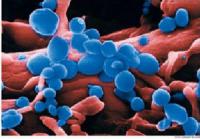-
Bill to jump-start universal flu vaccine efforts
As the nation grapples with a long and unrelenting flu season rivaling by some measures the 2009 H1N1 pandemic, a group of U.S. senators last week unveiled a proposal to invest $1 billion in research over the next 5 years to create a universal flu vaccine that would provide lifetime protection against a range of influenza strains. The announcement came just as U.S. researchers released an interim report card on the flu vaccine’s performance so far this season, which again showed disappointingly low effectiveness against H3N2, this season’s dominant strain.
-
-
Five finalists in $300K biothreat prize competition
Five finalists were announced today for Stage 1 of the $300,000 Hidden Signals Challenge. Issued by the DHS S&T, in collaboration with the Office of Health Affairs National Biosurveillance Integration Center (NBIC), the challenge calls for the design of an early warning system that uses existing data to uncover emerging biothreats. The announcement was made at the American Society for Microbiology’s 2018 ASM Biothreats meeting.
-
-
Distinguishing harmless bacteria from pathogens

Bacteria underpins much of our world, acting behind the scenes to affect the health and behavior of animals and plants. They help produce food, provide oxygen, and even reshape the environment through a vast array of biological processes. They come in a phenomenal number of strains—many still unknown—and thrive in different ecological and environmental niches all over the world. But while their diverse behaviors make them essential to life, bacteria can also be deadly. This threat only grows as greater global travel brings people into contact with new places, foods, and animals, dramatically increasing the chances of exposure to dangerous microbial species known as pathogens.
-
-
Comparing pollution levels before and after Hurricane Harvey
Hurricane Harvey, which made landfall in late August 2017, brought more than 64 inches of rain to the Houston area, flooding 200,000 homes, 13 Superfund sites, and more than 800 wastewater treatment facilities. As disasters become more frequent and populations living in vulnerable areas increase, interest in the health effects of exposure to the combination of natural and technological disasters has grown. A new study examined concentrations of polycyclic aromatic hydrocarbons (PAHs) before and after Hurricane Harvey in the Houston neighborhood of Manchester. Manchester, which is located near refineries and other industrial sites along the Houston Ship Channel, is a predominantly Hispanic neighborhood where residents face disproportionate health risks due to pollution and other environmental hazards.
-
-
S&T sponsors workshop on “sequences of interest”
Synthetic biology has led to the creation of new products, markets, companies, and industries. At the same time, the technology poses potential risks to biosafety and biosecurity, as recently demonstrated by the synthesis of horsepox virus, a cousin of variola, the virus which causes smallpox. DHS S&T sponsored a workshop to discuss the evolving role of databases which contain genetic sequences of pathogens and toxins — termed “sequences of interest” — which pose safety or security concerns.
-
-
Scientists call for better global and local control of mercury
Mercury is a complex, multifaceted contaminant which can take many different forms. It is poisonous to humans and wildlife and damaging to the environment. Currently, around two thirds of the mercury entering the environment comes from current or legacy human sources including mining, industrial activities, coal combustion and incinerators, with the remaining originating from natural sources. A special issue addressing the most up-to-date science on the fate and effects of mercury has now been published in the journal Ambio.
-
-
Massive reserves of mercury hidden in permafrost hold significant implications for human health
Researchers have discovered permafrost in the northern hemisphere stores massive amounts of natural mercury, a finding with significant implications for human health and ecosystems worldwide. The scientists measured mercury concentrations in permafrost cores from Alaska and estimated how much mercury has been trapped in permafrost north of the equator since the last Ice Age. Their study reveals northern permafrost soils are the largest reservoir of mercury on the planet, storing nearly twice as much mercury as all other soils, the ocean and the atmosphere combined.
-
-
CDC: Flu still rising across U.S.; 16 more pediatric deaths
“We are not out of the woods yet,” said Anne Schuchat, the acting director of the Centers for Disease Control and Prevention (CDC), as she described the rising influenza activity that’s swept across the United States. According to Schuchat, this past week brought yet another increase in influenza-like illness (ILI) activity, a spike in hospitalizations, and, most distressingly, 16 new reports of pediatric influenza deaths. Now 53 pediatric deaths this season have been attributed to the flu. The last season as severe as this year’s was in 2014-15, but at this point in that season the cumulative hospitalization rate was 43.5 per 100,000 population. This week that number was 51.4 per 100,000 population, according to the latest FluView surveillance data published by the CDC.
-
-
Worst-case global pandemic scenario: 700,000 dead, $500 billion in economic losses
The worldwide spread of a serious infectious disease could result in pandemic-related deaths of 700,000 and annual economic losses of $500 billion, according to a study. The dollar figure of economic losses is much higher than those found in previous studies, which, according to the study, means “there is an unmet need for greater investment in preparedness against major epidemics and pandemics.”
-
-
WHO: Widespread, high levels of antibiotic resistance across the globe
New surveillance data released earlier this week by the World Health Organization (WHO) reveals widespread and in some cases high levels of antibiotic resistance across the globe in the most common bacterial infections. “The report confirms the serious situation of antibiotic resistance worldwide,” Marc Sprenger, MD, director of the WHOs Antimicrobial Resistance Secretariat, said in a press release. “Some of the world’s most common—and potentially most dangerous—infections are proving drug-resistant.”
-
-
Mobility patterns influence the spread -- or containment -- of an epidemic

Contrary to expectations, recurring mobility between different cities or districts of a large city (for example, from home to work and back again) can minimize the spread of an epidemic. During an epidemic, common sense tells us that we should isolate ourselves from the rest of the population or reduce our movements to diminish the likelihood of contagion. However, far from improving the situation, isolating ourselves may increase our chances of contracting the disease and worsen the existing local situation.
-
-
U.S. flu levels continue to climb, with 37 pediatric deaths confirmed
With seven more pediatric deaths reported last week and influenza-like illness (ILI) numbers that are nearing those seen during the 2009 pandemic, the Centers for Disease Control and Prevention (CDC) said today that this year’s flu season will most likely be considered severe. In its weekly FluView report, the CDC said the total of pediatric deaths has now reached 37. Hospitalizations also continued to rise, with the vast majority (88.7 percent) of hospitalizations were associated with influenza A. Of those A strain infections that required hospitalization, 86.4 percent were H3N2 and 13.6 percent were 2009 H1N1.
-
-
$1 billion reward proposed for development of new antibiotics
An international group tasked with researching and developing new economic models to promote antibiotic development is calling for a $1 billion market entry reward for new antibiotics, saying the reward could significantly boost the number of new antibiotics coming to market over the next thirty years. The proposal was made by an international consortium of public health organizations, academic institutions, and pharmaceutical companies supported by the European Medicines Initiative. The $1 billion market entry reward is one of four incentives proposed by the group to stimulate research and development (R&D) for new antibiotics and ensure that critically needed antibiotics are used sustainably and continue to be accessible. “Without incentives, some scientifically promising treatments would probably never make it to patients,” says one expert.
-
-
The man who knew too much

In November 2006, on orders of Vladimir Putin, Russian operatives used radioactive material to poison and kill Alexandr Litvinenko, a former KGB colleague who had turned a fierce critic of the Russian leader, and who was living with his family in London. Yesterday, the British government froze the assets of the two Russian agents – one of them has been awarded a medal by Putin, and is now a leading member of United Russia, Putin’s political party, in the Russian parliament. Ten years later, in November 2016, a leading British nuclear forensic scientist – who was part of the 2006 investigation and who was instrumental in tying the nuclear material used in the killing to the two Russian agents — was found dead in his home, after returning from an academic research trip to Russia. It was the 14th Russia-related killing on British soil since 2006. The number of individuals with inside knowledge of the Putin regime and its practices — and who have met an untimely end in mysterious circumstances — is growing, and British lawmakers urge the government to show more resolve in investigating this string of killings.
-
-
Radioactivity from oil, gas wastewater persists in Pennsylvania stream sediments
More than seven years after Pennsylvania officials requested that the disposal of radium-laden fracking wastewater into surface waters be restricted, a new study finds. The contamination is coming from the disposal of conventional, or non-fracked, oil and gas wastewater, which, under current state regulations, can still be treated and discharged to local streams.
-
More headlines
The long view
We Ran the C.D.C.: Kennedy Is Endangering Every American’s Health
Nine former leaders of the Centers for Disease Control and Prevention (CDC), who served as directors or acting directors under Republican and Democratic administrations, serving under presidents from Jimmy Carter to Donald Trrump, argue that HHS Secretary Roert F. Kennedy Jr. poses a clear and present danger to the health of Americans. He has placed anti-vaxxers and conspiracy theorists at top HHS positions, and he appears to be guided by a hostility to science and a belief in bizarre, unscientific approaches to public health.
